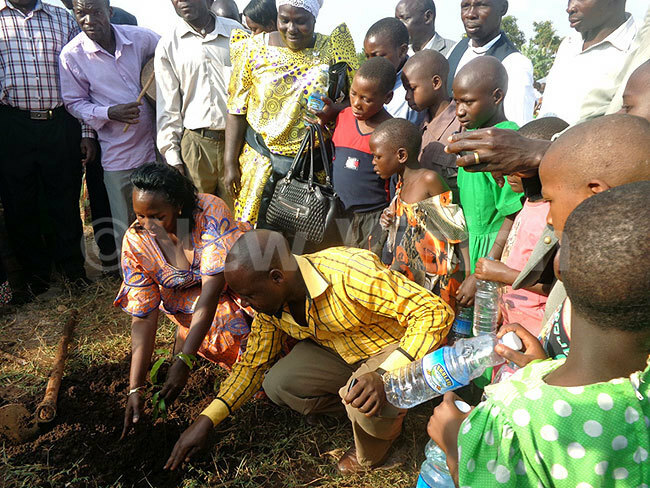Kyankwanzi to get five new schools
Jul 20, 2017
The schools will be built in three months, according to Building Tomorrow.

PIC: RDC Robert Kashaija and Woman MP Ann Nankabirwa are joined by children to plany a tree at the ground-breaking function for Kijubya Build Tomorrow Primary School. (Credit: Nelson Kiva)
EDUCATION
As many as five schools are going to be built in Kyankwanzi district, a move that will go a long way in helping the local children attain an education.
The schools will be constructed in the sub-counties of Byerima, Butemba, Kyankwanzi and Bananywa.
During a ground breaking for the construction of a primary school in Kijubya village this week, Woman MP Ann Maria Nankabirwa said Building Uganda had offered to support the district with five schools.
She said that when she got concerns from the villages that lacked schools, she embarked on lobbying for support to solve the problem. And with guidance from the education ministry, she was connected to the NGO, who offered to help.
The schools will be built in three months, according to Building Tomorrow country director Joseph Kaliisa Bagambaki, who was represented by Doreen Namugenyi, a coordinator.
To come to fruition, the community is expected to offer unskilled labour and other necessary support while the district agreed to provide furniture and staff once the projects are complete.
The NGO said that at each school, they will build seven classroom blocks, a nursery section, headteacher's office, staff room and latrines for teaches and pupils, on top of designing the compound.

MP Nankabirwa is joined by residents to plant a tree during the ground-breaking ceremony for Kijubya. (Credit: Nelson Kiva)
Kyankwanzi resident district commissioner, Robert Kashaija, assured that government would immediately code the schools.
On his part, district LC5 vice-chairperson Andrew Ntege admitted that the support was timely as the district could not have managed on its own due to resource constraints.
Records indicate that many children in the district are engaged in child labour or married off.
District education officer, Ibrahim Kabuka, said the few that attend school trek long distances to get there.
He says that government policy requires that every parish has a public primary school and a universal secondary school for a sub-county.
In reality however, more than 12 parishes with over 30 villages have no access to primary education while seven sub-counties lack government-aided secondary schools.
For instance, in Kijubya parish in Byerima sub-county, authorities estimate that over 500 children of school-going age of 5-15 are out of school.
The sub-county chief, Peninah Kabonesa, said a child from Kijubya village must trek over six kilometers to the nearby Byerima Primary School.
Mande Venansio, the parish councilor for Kijubya, said he had started a private school in the area to support education but he realized that over 80% of the parents could not manage to pay school fees.
He said he has since given the three-acre piece of land to the community for the establishment of a public school.
